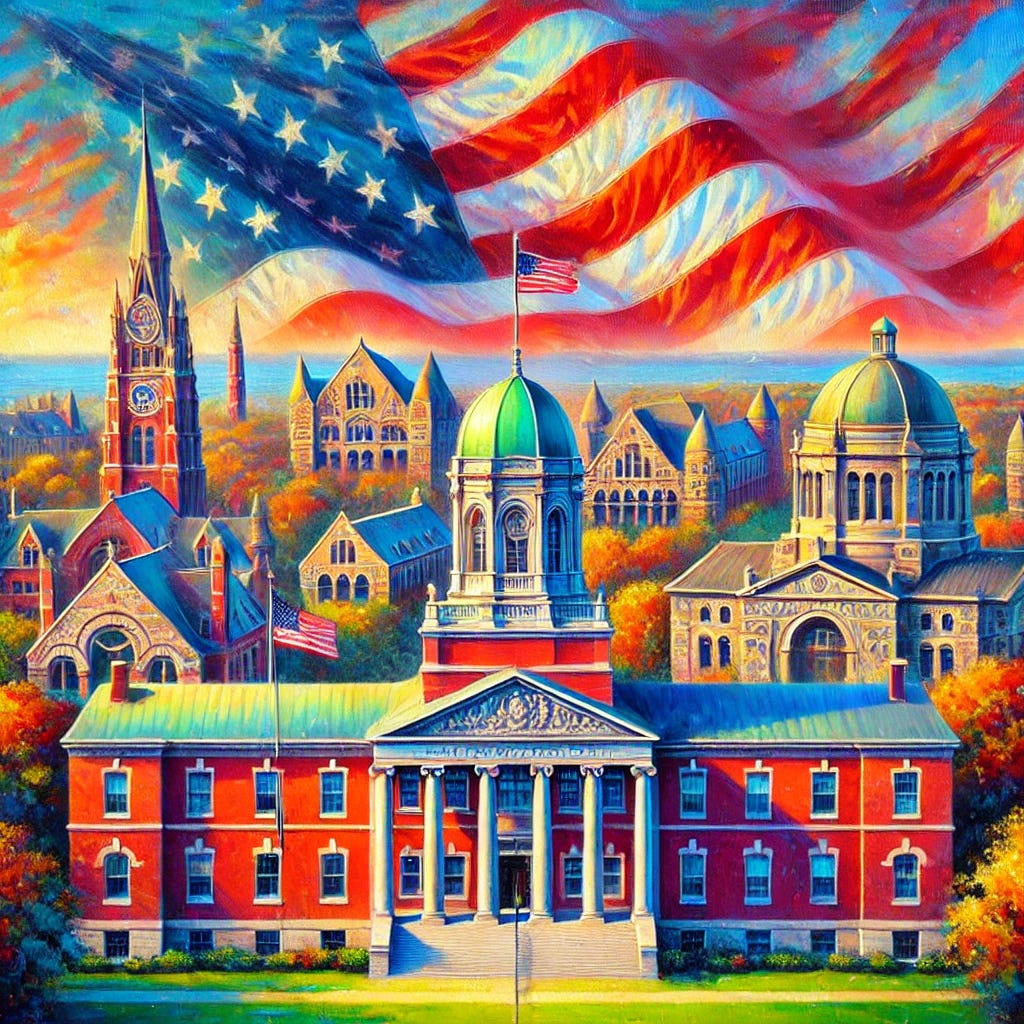Are Brick and Mortar Educational Institutions in USA Heading Towards Extinction?
With rising costs and the rise of digital learning alternatives, traditional colleges are facing unprecedented challenges. Will they adapt and thrive, or are they on the path to obsolescence?
The Soaring Cost of US Higher Education
For decades, a four-year college degree from a traditional institution has been seen as the key to career success and middle-class stability in America. However, as the cost of higher education continues to climb, many are beginning to question the value of the traditional college experience.
The Rising Price Tag
Over the past several decades, the cost of attending college in the US has grown at an alarming rate. According to data from the National Center for Education Statistics, the average total cost of a four-year institution rose by 155% between 1963 and 2021. Today, the average annual cost for in-state students at a public university is $24,030, while private nonprofit universities average $56,190 per year.
The reasons for this dramatic increase include:
Growing demand as college degrees have become essential for well-paying jobs.
Decreasing state funding for public universities.
Competition among institutions leading to higher spending on facilities and administrative staff.
Declining enrollment, particularly since 2010, resulting in budget deficits for many colleges.
Challenges on the Horizon
The future for traditional colleges looks uncertain. Many institutions are still struggling to recover from the financial impact of the COVID-19 pandemic. Adding to this is the "enrollment cliff," an anticipated drop in the number of high school graduates due to declining birth rates following the 2008 recession. This demographic trend is expected to peak within the next few years, further straining college budgets.
Emerging Alternatives Reshaping Higher Education
As the cost of traditional higher education continues to rise, more affordable and flexible alternatives are gaining momentum, potentially reshaping the future of learning.
a.) Free Online Resources
The internet has made access to educational content more accessible than ever. Platforms like YouTube, Khan Academy, and Coursera provide vast amounts of knowledge on a range of subjects at no cost, enabling learners to acquire skills without the need for traditional tuition fees.
b.) Massive Open Online Courses (MOOCs)
MOOCs have transformed the online learning landscape by offering courses from top universities worldwide at little to no cost. Platforms such as edX, Udacity, and FutureLearn allow students to gain valuable skills and even earn certificates or micro-credentials recognised by employers.
c.) Coding Bootcamps and Vocational Training
Specialised short-term programs, particularly in technology and skilled trades, have seen significant growth in recent years. Coding bootcamps, for instance, offer intensive training in tech fields, often leading to high job placement rates at a fraction of the cost of a traditional degree.
d.) Remote Learning and Virtual Classrooms
The widespread use of video conferencing tools like Zoom has made remote education a more viable and accepted option. This shift has enabled greater flexibility for students, reduced infrastructure costs for institutions, and led to the creation of hybrid and fully online degree programs tailored to the needs of working adults and those balancing family commitments.
e.) Artificial Intelligence in Education
AI is playing an increasingly important role in shaping personalised, adaptive learning experiences. AI-powered platforms can tailor content to an individual’s learning style, provide instant feedback, and even offer virtual tutoring services. Companies like Carnegie Learning and Third Space Learning are pioneering these approaches, enhancing educational outcomes.
f.) Alternative Credentialing
The rise of digital badges, micro-credentials, and industry-specific certifications is challenging the traditional degree model. Major companies like Google, IBM, and Amazon now offer their own certification programs, which are often more affordable and directly relevant to today’s job market.
Economic Impact of International Students
International students play a crucial role in the U.S. higher education system, contributing significantly to both the academic environment and the national economy. These students often pay much higher tuition rates than their American peers, particularly at public universities. For example, at many state universities, out-of-state and international students may be charged two to three times more than in-state residents. This higher tuition income not only helps subsidise the cost of education for domestic students but also provides essential revenue streams that universities depend on to maintain their operations, develop new programmes, and enhance facilities.
Shifting Demographics: India and China Lead the Way
India and China have long been the largest contributors to the international student population in the U.S., but recent data shows a shift in this dynamic. According to the Open Doors Report, in the 2022-2023 academic year, Indian students surpassed their Chinese counterparts, becoming the top source of international students for the first time since 2009-2010. Indian students numbered 268,923, making up over 25% of the more than one million foreign students in the U.S. Chinese students, while still a significant presence, now play a secondary role. The influx of students from these two nations not only adds to the diversity and global perspective of U.S. campuses but also contributes substantially to the economy, with international students injecting over $40 billion into the U.S. economy in 2023, according to NAFSA.
Pathways to Employment and Citizenship
For many international students, pursuing higher education in the U.S. is more than just an academic endeavour—it is seen as a stepping stone to employment and, eventually, citizenship. The Optional Practical Training (OPT) programme allows international students to work in their field for up to 12 months after graduation, with STEM graduates eligible for a 24-month extension. Many students use this period to secure H-1B visas, enabling them to work in the U.S. for up to six years. This often serves as a bridge to permanent residency through employment-based green cards. Although the path from international student to U.S. citizenship is long and complex, it remains a powerful incentive for those who view their U.S. education as the foundation of a future in the country.

The Future of Higher Education: A Path Forward for Traditional Institutions
The continued rise of alternative education models presents significant challenges to traditional colleges and universities, especially those without strong financial backing or unique value propositions. Many smaller institutions are struggling with declining enrollments and budget deficits, resulting in program cuts and faculty reductions. Even some large public universities, such as West Virginia University, have faced similar financial pressures, prompting difficult decisions to remain operational.
The Resilience of Elite Institutions
Despite these challenges, traditional brick-and-mortar institutions, particularly those with strong legacies, prestigious global reputations, and high-quality educational offerings, remain well-positioned to withstand these disruptions. International students, as previously discussed, play a crucial role in this resilience. They not only provide significant financial contributions through higher tuition fees but also enrich the academic and cultural environment of U.S. campuses. The enduring demand from countries like India and China demonstrates the ongoing global appeal of U.S. higher education, particularly at elite institutions.
A Diversified Education Landscape
As alternative education models gain traction, the higher education landscape is likely to diversify further. Students will increasingly turn to a mix of online courses, vocational training, and industry certifications as alternatives to traditional four-year degrees. However, elite institutions still offer unique advantages that are difficult to replicate. These include not only top-tier academic programs but also extensive networking opportunities, access to influential alumni networks, and a reputation that can provide a competitive edge in the job market.
Adaptation Is Key for Survival
To thrive in this changing environment, traditional colleges and universities must adapt. This includes embracing technology, expanding hybrid and online learning options, and offering more flexible and affordable degree pathways. Partnering with industries to ensure curriculum relevance will also be essential, as students increasingly seek educational experiences that directly prepare them for the workforce. By aligning their offerings with market demands, traditional institutions can continue to attract students seeking both quality education and employability.
Cautious Optimism for the Future
While the higher education sector is undoubtedly undergoing a period of significant disruption, there is room for cautious optimism regarding the future of brick-and-mortar institutions. Those that maintain high standards of education, leverage their brand strength, and offer unique value propositions—such as strong networks and in-person learning experiences—will likely continue to play a pivotal role. The coming years will likely see a hybrid model of education emerge, blending the best of traditional and alternative methods to meet the evolving needs of students and the workforce. This adaptation will ensure that brick-and-mortar institutions remain relevant and essential to the future of higher education.





